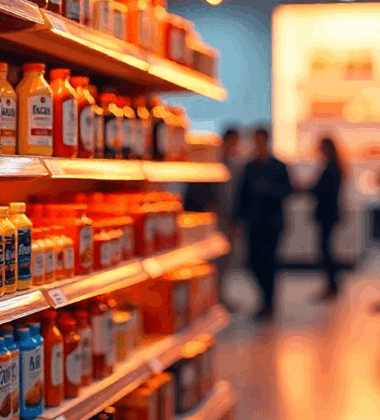In the age of rapid innovation and consumer-led demand, the question for food brands isn’t can we make it?—but should we make it, and how will it taste?
The answer lies in expo testing, the art and science of real-time product validation through flavor, texture, scent, and experience. Now more than ever, food expos are not just show-and-tell spaces—they’re sensory laboratories.
Welcome to the new frontier of sensory R&D, where culinary creativity, data collection, and human perception converge to shape the future of food. If you’re a product developer, flavor chemist, or brand innovator, understanding how expo testing works could be your secret edge.
Why Sensory Testing at Expos Matters More Than Ever
Imagine you’ve spent 9 months formulating a functional snack with adaptogens and umami flavor profiles. You’re confident about the science. But will your consumer actually like the taste?
You could wait to find out in post-launch sales data—or you could test the concept with real humans before it hits shelves.
That’s the power of expo testing. At events like the Global Products Expo USA (June 26–28, 2025, at the New Jersey Expo Center), you’re not just displaying your food innovation—you’re immersing thousands of buyers, scientists, chefs, and influencers in it. And their reactions? Priceless.
The Role of Sensory R&D in Innovation Pipelines
At the heart of any successful F&B product is a sensory profile that delights the palate, aligns with consumer expectations, and triggers emotional memory. Sensory R&D focuses on:
- Flavor mapping
- Mouthfeel and texture analysis
- Aroma pairing
- Aftertaste measurement
- Sound (yes—crunch counts)
- Visual appeal and color psychology
At expos, you get live, unfiltered sensory feedback in a controlled yet dynamic setting—ideal for data-rich iteration.
Expo Testing: Where Feedback Meets Formulation
Unlike traditional lab settings or closed consumer panels, expo testing offers immediacy and authenticity.
1. Real-Time Reaction Metrics
Whether you’re debuting a plant-based steak, a nootropic soda, or a heat-level-tunable hot sauce, expo booths allow you to gather:
- Facial expression tracking (via AI-equipped screens)
- Tasting response scores (via tablets or QR code surveys)
- Dwell time around sensory booths
- Conversation snippets for sentiment analysis
These aren’t vanity metrics. They are predictors of market viability.
2. Multi-Sensory Sampling Stations
Savvy brands are now designing 360-degree sampling experiences that test more than just flavor:
- Temperature-controlled bites to test warmth perception
- Audio overlays to study the role of sound in food perception
- Aroma tunnels to test scent-led recall
These immersive setups, often showcased at the Global Products Expo, go beyond standard samples to test how memory, attention, and emotion interact with taste.
3. Pre-Commercial Prototype Testing
Some of the most forward-thinking brands use expo testing to introduce alpha-stage product concepts—with unfinished branding, flexible formulas, and multiple variants.
Why?
Because they want to listen before they lock. Expo testing allows them to:
- Run A/B tests on ingredient blends
- Gauge emotional language used by tasters
- See which version garners more buzz organically
It’s open-source R&D—with massive ROI.
Who’s Doing It Best? Expo Testing in Action
Here are three standout brands that used expo testing to accelerate innovation:
A. NeuroSip – Cognitive Beverage Line
This brand set up a “brain bar” at the 2024 Expo where attendees self-selected drinks based on desired mental states (focus, calm, clarity). They tracked which blends had the highest taste satisfaction and biometric stress-reduction effects using wearables.
Result: Reformulated the hero product based on crowd-favorite pairings of L-theanine and yuzu, launching nationally 4 months later.
B. Textura – Crunch Mapping with AI
A snack brand seeking the “perfect crunch” invited attendees to chew into AI-sensor chips that captured texture preference data.
Result: Identified the ideal bite pressure and crisp factor preferred by Gen Z vs Boomers, leading to age-targeted formulations.
C. Fermenté – Gut-Health Ice Cream
Debuting a dairy-free probiotic ice cream line, Fermenté let attendees try samples at different fermentation stages.
Result: Discovered higher consumer approval for the mid-fermentation flavor (milder tang, smoother mouthfeel), pivoted production accordingly.
What Expo Testing Reveals That Surveys Don’t
Unlike written surveys or digital A/B tests, expo tasting engages the full human system—and taps into insights even consumers may not consciously articulate.
Expo testing answers:
- Which unexpected ingredients spark delight?
- Where is the flavor story falling short?
- What’s driving hesitation or surprise?
This is especially useful in launching:
- New texture formats (e.g., aerated chocolate, popping pearls)
- Functional ingredients with strong flavor profiles (e.g., ashwagandha, moringa)
- Cross-cultural fusions (e.g., za’atar popcorn, tamarind sodas)
You’re not just testing taste. You’re testing acceptance.
Designing Your Sensory Booth: Testing with Purpose
To get meaningful data from expo testing, your booth needs to be more than eye-catching. It needs to be structured for sensory feedback.
Key Elements:
- Feedback Kiosks: Include touchscreen inputs, rating scales, and optional voice memos
- Variant Comparison: Let tasters sample side-by-side and choose favorites
- Emotional Recall Prompts: Ask open-ended questions like “What does this flavor remind you of?”
- Heat Mapping: Track foot traffic and time spent to identify engagement peaks
The Neuroscience Behind Tasting Events
The science of expo testing aligns with what we know about memory encoding and food perception:
- Novelty triggers dopamine (exploration reward)
- Multi-sensory alignment improves brand recall
- Storytelling around ingredients increases perceived flavor quality
- Real-world environments (like expos) create episodic memories, making the taste experience more sticky
Want your product remembered after the show? Design it to be emotionally anchored.
Future Trends in Expo Testing
The next wave of expo R&D will see a blend of AI, biofeedback, and personalized experiences.
Look out for:
- Flavor preference prediction tools based on DNA or microbiome
- AR-enhanced tasting menus to visualize ingredient sourcing
- Scent-based wayfinding: Using aroma zones to guide attendee movement
- AI mixologists offering custom mocktails based on mood inputs
And behind it all? Rapid, agile expo testing to validate what works—before the competition even notices.
Making It Actionable: From Expo to Lab to Market
Here’s how to turn expo insights into product innovation:
- Debrief Immediately
Capture data and emotional responses while they’re fresh. - Synthesize Trends
Look across feedback for recurring likes, dislikes, ingredient mentions. - Refine Prototypes
Adjust sweetness, mouthfeel, or format based on top insights. - Re-test at Micro Scale
Use pop-ups or digital sampling to test refined versions. - Launch Strategically
Use expo insights in your marketing: “Refined live at Global Products Expo 2025.”
Final Taste
Expo testing isn’t just a fun brand activation—it’s one of the most efficient, cost-effective, and emotionally resonant forms of sensory R&D available today. It transforms trade shows into laboratories, consumers into co-creators, and feedback into forward momentum.
At a time when product failure is expensive and consumer loyalty is fragile, testing what’s next before committing is simply smart business.
So the next time you’re at an expo—whether launching or scouting—pay attention to what people are tasting, feeling, and saying. That flavor on their tongue? It might be the future of food.





